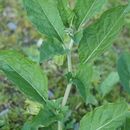The genus Anisodus
provided by EOL authors
Anisodus is a small genus in the Solanaceae (the nightshade or tomato family). All species are Asian, which is a bit unusual for the family, whose center of diversity is in the tropical Americas. Since the early 1800s, about 12 species have been named, but most have now been moved to other genera or synonymized with other species. These plants are perennials which may become somewhat shrubby, and generally reach about 1 m tall (3 to 4 feet). The nodding flowers are greenish to purplish or mixtures thereof and are about 2.5 cm long (1 inch). The calyx is nearly the size of the corolla, may enlarge in fruit, and wraps around the mature capsule. Anisodus luridus is occasionally cultivated outside of China as an ornamental, though it is more interesting than showy. Most species of Anisodus have medicinal uses in China, but like the majority of the Solanaceae, they are also toxic, so caution must be applied. TAXONOMY: Historically, few specimens of Anisodus were available for study by European botanists. Many of these species were moved in and out of a variety of genera as taxonomists tried to figure out where best to place them based on incomplete information. Because of the persistent, enlarged calyx, some of these plants were placed in other large-calyxed genera like Nicandra and Physalis. They have also been placed in Scopolia, Mandragora, Atropanthe, and Whitleya. All genera but Whitleya are still recognized (though they don't necessarily all still contain members of Anisodus). Currently, four species remain in Anisodus. According to the Flora of China, these are A. acutangulus, A. carniolicoides, A. luridus, and A. tanguticus. PHYLOGENY: A cpDNA phylogeny of the Solanaceae places Anisodus in the tribe Hyoscyameae, along with Atropa, Atropanthe, Hyoscyamus, and Scopolia (Olmstead et al., 2008). This tribe consists of Old World, mostly capsule-forming genera. Mandragora and Nicandra did not cluster with any subtribe, and Physalis was nested within the Physaleae. All of these genera fall into the subfamily Solanoideae.
Anisodus: Brief Summary
provided by wikipedia EN
Anisodus is a genus of flowering plants in the family Solanaceae.
- license
- cc-by-sa-3.0
- copyright
- Wikipedia authors and editors

